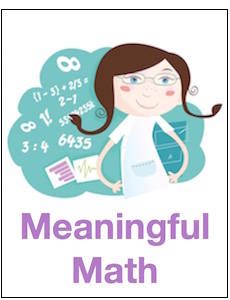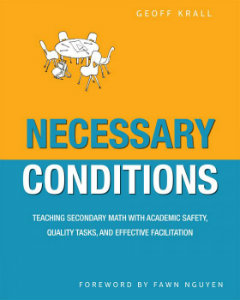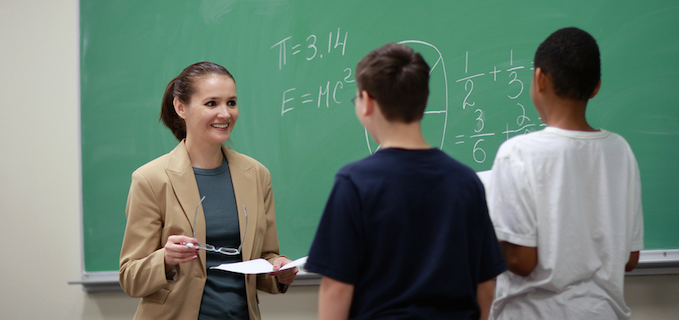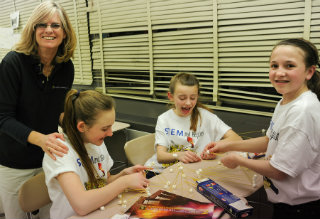How Can We Help Kids Become ‘Math People’?
A MiddleWeb Blog

The fact that I was able to finish this wonderful book – Necessary Conditions by Geoff Krall – speaks to how engaging it is.
It is so good, in fact, I am going to reread it this summer. In case you can’t tell – I’m a new major fan of Geoff Krall! If you teach in grades 6-12 and are looking for a book to read related to math education, this is a great one. (Full disclosure: I received a free copy with the option to write about it if I chose to.)

I will share what clicked with me from each main section, but I sincerely encourage every person who teaches or plans to teach math to read this book.
What is it about and how is it laid out?
As the title suggests, this book explains how to provide the “necessary conditions” for every student to have the opportunity “to recognize that they are … a math person.” The three necessary conditions that Krall lays out are (1) Academic Safety, (2) Quality Tasks, and (3) Effective Facilitation. More detail on these three conditions below.
The book has a section for each of the three conditions as well sections which deal with implementing the conditions in our lessons and assessments, and ultimately in system-wide changes. The appendix contains a task-quality checklist, a sample list of classroom norms, a student work analysis protocol, a student attitudes survey, a video lesson protocol, and more.
After the appendix there is a task library which contains examples and templates for quality tasks. There are many lists, checklists, rubrics, tasks, and student surveys that I plan to print and put in sheet protectors so I can reuse them throughout the year.
1st Necessary Condition: Academic Safety
I’m going to be honest here: I had planned to skim through this section. I was thinking my classroom is pretty safe and maybe I didn’t need that information so much. I was so wrong! Instead of skimming I bookmarked and highlighted almost every page. I learned so many things I could do differently and do better.
For instance, I learned that an academically safe classroom is one that “honors the individual student while leveraging social interactions to build up self-regard” (page 28). I like that! Honoring the student and building up their mathematical self-regard: you can’t beat that as a goal for math teachers. This section has so many good ideas; I’m listing my personal favorites here.
►Thoughtfulness over Speed
One suggestion to build up students’ mathematical self-regard is to shift the focus from speed to thoughtfulness. After reading this section, I realized that I have inadvertently prioritized speed over thoroughness and attention to detail. Thankfully the author provided five tips to help me prioritize thoughtfulness over speed:
- Review content from prior days’ lessons
- Grade only what students produce
- Prioritize standards
- Give students all the time they need for assessments
- Establish “speed is not important” as an explicit and lived-out norm.
►Being an “Active Carer”
The section entitled “Passive Caring versus Active Caring” made an impression on me. Krall provides a chart that contrasts passive and active caring, and many times as I was self-assessing I had to check the box under passive, so I have some work to do.
For example, “teacher allows retakes on exams” is an example of passive caring, while “teacher allows retakes and reaches out to specific students and encourages them to retake an exam” is active caring. When a “teacher offers general praise” that is passive caring, and when a “teacher offers authentic praise specific to each student” that is active caring (page 43).
►Authentic Praise
Speaking of praising students, I cannot leave this section without sharing what one school did to “assign academic status” to their students. The teachers make it their aim to praise every single one of their students for a mathematical skill. The norms they developed required that their praise involve four components: (1) praise must be public; (2) it must be specific; (3) it must be mathematical, and (4) it must be true. I try to praise my students, but I had not thought about it in such a logical way. I am truly excited to try this!
2nd Necessary Condition: Quality Tasks
What is a quality task? It can be hard to pin down a definition for a quality task. One teacher said they knew it was a good task when “students begin working on it before I tell them to.” I think as teachers we all want that! The book provides five elements identifying quality tasks (page 53):
A quality task:
- Sparks curiosity and foster engagement
- Yields creativity and lead to new ideas
- Promotes access for all students in the classroom
- Requires and conveys deep, crucial mathematical content
- Connects and extends content
For each element, practical suggestions and tips are provided. Krall also provides actual examples of quality tasks. For several of the tasks, I couldn’t resist actually working through them right then!
Not sure what specific tasks you should use in your classroom? Don’t worry, the book provides “Ten Essential Task Types” (along with explanations and examples):
1.) Number talks
2.) Estimation
3.) Always/sometimes/never
4.) Which one doesn’t belong
5.) Polygraph or Guess Who?
6.) Card Sorts and Dominoes
7.) Would you rather?
8.) Three-Act Math
9.) Problem-Based Learning
10.) Project-Based Learning
The prep time varies for these tasks. Some require very little prep time, others require a bit more. Also, some can be completed in a few minutes at the beginning of class while others will take several class periods. I would have loved to have had this book my first year of teaching. Just to have that list of 10 tasks that I could put in my teacher toolkit would have helped so much!
3rd Necessary Condition: Effective Facilitation
The author defines facilitation as “the teacher actions that result in student understanding of the task, concept, and other outcomes.” Facilitation is further broken down between short term and long term facilitation.
Long term (weeks, months, or the entire school year) facilitation would include establishing classroom norms, structures and routines. Group work is thoroughly addressed in this section, and suggestions are provided to help the teacher train students to work productively in groups.
Much emphasis is placed on teachers training and preparing students to work in groups. Instead of just expecting students to know how to act, teachers are encouraged to be very explicit about their expectations.
Short term facilitation would involve a much shorter period of time, addressing a single task. The suggested framework for a task is:
- Posing the task and initial brainstorming
- Scaffolding and workshops
- Sharing solutions and debriefing
For every step there are suggestions for how to proceed. For instance, when doing initial brainstorming, perhaps incorporate estimation or engage in “notice and wonder” discussion.
Putting the Pieces Together
As the title of the chapter indicates, this chapter helps readers put the pieces together when implementing the three necessary conditions. It discusses how to plan a lesson, problem solve, and assess.
►Planning a Lesson
Planning a lesson begins with choosing a quality task, and there is a great checklist to help a teacher decide if a task is of sufficient quality. It’s actually a rubric which allows the teacher to assign a number value to a task. This can be done individually, or (even better) with your department. There is a task sort protocol to help whole departments work together to assess a task or group of tasks (page 157).
Regarding the framework for a full lesson, Geoff Krall suggests that the lesson will have a
- Warm-up
- Task launch
- Student work time
- Solution sharing
- Debrief
- Closing
He provides activities and protocols for each element.
►Facilitating Problem Solving
This section deals with what happens when students are expected to solve problems, and it reminded me of a mistake I commonly made in my classroom when I first began teaching (I still do sometimes). It is one of extremes. I would either go the over-scripted route and give students a step-by-step procedure to follow or go to the other extreme and think I needed to be hands-off so they could figure out the problem for themselves.
Krall points out that both extremes are equally destructive. By being hands-off I was “passively assigning” problems when I needed to be “facilitating.” There is a big difference between the two!
Facilitating involves making sure every student (or group) understands the problem. It also requires finesse when offering help so that we share strategies but not solutions. Norms, such as a routine for group work, are vital.
Also, you need to plan for the unplanned. There may be unexpected challenges for the students that we have to address, and we need to be ready for that. Facilitating definitely requires a hands-on approach!
►Assessment
Students are required to take standardized tests, many standardized tests. Teachers have to put in grades based on benchmarks and end-of-unit tests. This can diminish a student’s mathematical self-regard. The author provides an interesting and alternate way to gauge “mathematical smartness.” It involves answering six prompts which the students use as a basis for self-refection:
- I persisted through challenging problems
- I communicated ideas as cleanly as possible
- I demonstrated creativity
- I tried several approaches to the problem
- I encouraged my peers
- I found meaning in my work
Just by giving students these prompts, I will be showing them what I value in my classroom.
Final Thoughts about the Book
What is so valuable about Necessary Conditions is that it gets down to the “nuts and bolts.” It’s not just a book about theory that leaves you floundering when you try to actually implement the theories in your classroom. (There are also free Support Materials at the publisher’s book page.)
I’m glad I’m reading it during the school year because I still see students every day and can start implementing some of what I am reading about right now! When I read a book, I try to select at least three things I want to try. Here are the three I plan to start with from Geoff Krall’s excellent resource.
- Systematically praise each one of my students using the following criteria: praise must be public; it must be specific; it must be mathematical, and it must be true.
- Move from “Passive Caring” to “Active Caring” (using the chart on page 43 as my guide).
- Incorporate the “Ten Essential Task Types” into my lessons.
I hope to be able to write about the impact soon!


































Simplifying math, the concept of math and math problems and connecting it to real life situations plays a massive role in helping general and special education students come to love and engage in solving mathematical problems. Articles, views and experience-sharing of professionals like Michelle play great roles in not only making kids into math people but also inspiring them to be advocates for studying mathematics. Thanks a million.